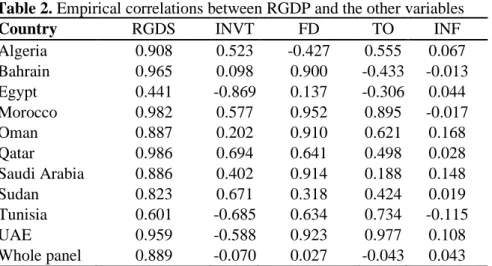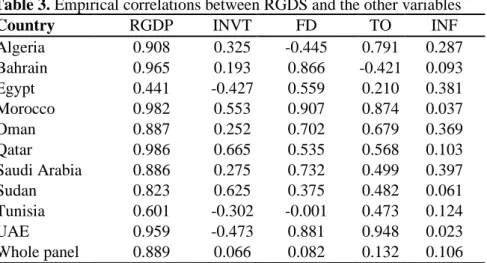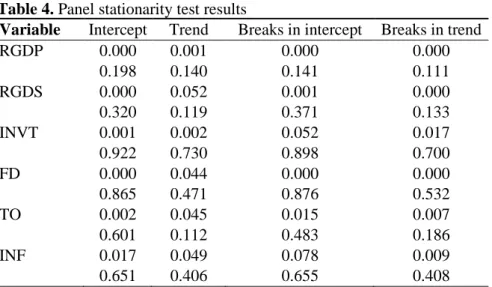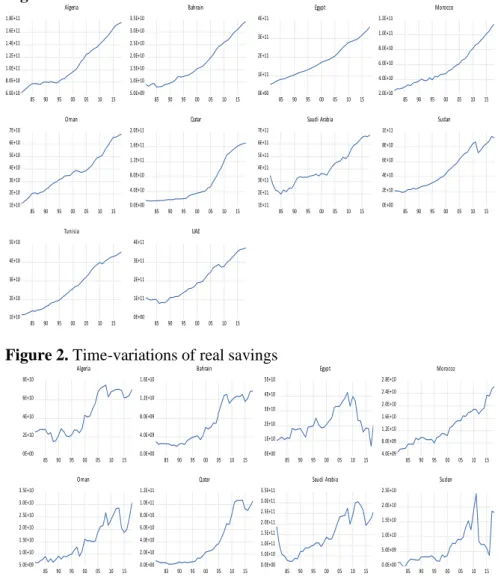In this context, particular attention is paid to the direction, sign and extent of the causality between economic growth and savings, thereby helping policymakers to handle the output-savings nexus well. The results of the study are in line with expectations and show evidence of co-integrating relationships between economic growth and savings when controlling for auxiliary determinants in the model. It is also worth noting that only few empirical studies in the literature have addressed the issue of the links between economic growth and savings for the Arab region, in addition to the shortcomings related to the methodologies used in some works.
We continue in the same momentum of empirical studies regarding the relationship between economic growth and savings using panel. In doing so, we accurately assess the bidirectional causal relationships between economic growth and savings in both the long and short term, and provide appropriate policy implications to the Arab authorities. Significant responses of both economic growth and savings to the fluctuations in aid determinants are also found in both the long and short term.
Useful policy implications of the results are provided to decision makers in the considered Arab economies to help them increase economic growth and savings.
Literature review
In a similar study, Mohan (2006) shows that the causal relationships between output and saving depend on the income class of the country. Odhiambo (2009) reveals that economic growth and savings for South Africa cause each other in the short term and that causality runs from economic growth to savings in the long term, thus suggesting that policy makers should advocate policies to both economic growth and economic growth to promote. saving in the short term and only economic growth in the long term. By cons, Irandoust and Ericsson (2005) reveal that economic growth responds significantly to the changes in savings for a set of African economies.
Kónya (2005) shows evidence of bidirectional causality between economic growth and savings for the Austrian economy as well as unidirectional causality across economies with different income levels. Jouini (2016) finds that economic growth and savings are mutually and positively linked over both the long and short term in Saudi Arabia, which therefore implies that authorities should establish policies to achieve higher levels of both economic growth and savings.
Model and data
We consider annual data covering the period 1981-20182 for ten Arab economies, namely Algeria, Bahrain, Egypt, Morocco, Oman, Qatar, Saudi Arabia, Sudan, Tunisia and the United Arab Emirates (UAE). Real GDP, real GDS and inflation data are from the United Nations Conference on Trade and Development (UNCTAD) database, while investment, financial development and trade openness data are collected from the World Development Indicators database ( WDI), published by the World Bank.
Econometric methodology
The coefficients 𝑎𝑖, 𝑏𝑖, 𝑐𝑖 and 𝑑𝑖 are country-specific effects, the error correction term coefficients 𝜃1𝑖 and 𝜃2𝑖 measure, respectively, the speed of adjustment of short-term deviations from real GDP and real savings towards long-term equilibrium, the coefficients 𝜑1, 𝑖𝑙 and 𝜑2,𝑖𝑙 assess the short-term own past effects of real GDP and real savings, respectively, the coefficients 𝛾1,𝑖𝑗 and 𝛿1𝑖 (𝛾2,𝑖𝑗 and 𝛿2𝑖) measure the short-term effects of the variables on real GDP (actual savings), and the optimal trailing orders 𝑝1, 𝑞1, 𝑝2 and 𝑞2 are determined by applying the Schwarz Bayesian information criterion. We use the maximum likelihood method and the Newton-Raphson optimization algorithm to obtain asymptotically consistent and normally distributed estimators. The long-term relationship coefficients are identical in the selected Arab countries, as illustrated by Eq.
This homogeneity of long-term coefficients can be explained by. common technologies, arbitrage conditions, and budget constraints or solvency. Under this homogeneity assumption, Pesaran et al. 1999) argue that coefficient estimates in the long run are stable and efficient. However, the model coefficients are assumed to be heterogeneous in the short run, as illustrated by Eqs. 3) and (4), thereby allowing the dynamic specifications to differ across economies.
Under these conditions, the short-term estimates are obtained by averaging the coefficients across countries.
Discussion of the results
Preliminary data assessment
The descriptive statistics shown in Table 1 reveal that Saudi Arabia records the highest average real GDP and real savings followed by the UAE, which can be explained by the increase in hydrocarbon exports in both countries and the development of the service sector in the UAE. On the downside, Bahrain records the lowest average real GDP and Tunisia has the lowest average real savings. It is also worth noting that the average real GDP for Egypt, Saudi Arabia and the UAE is greater than the average real GDP for the entire group of countries.
In addition, the average savings for Algeria, Saudi Arabia and the UAE exceed the average savings for the entire group of countries. The empirical correlations presented in Tables 2 and 3 are calculated across countries and across the entire panel. The values by country show that real GDP and real savings are positively and strongly correlated for eight out of ten countries.5 For the entire sample, there is evidence of a positive and high correlation between real GDP and.
4 Savings decline from 2011 in Egypt and Tunisia due to the events of the Arab Spring that broke out in January 2011. Sudan's records decline in savings from 2012 due to South Sudan's independence on 9 July 2011, before recording an improvement in 2017. 5 the correlation between real GDP and real saving is positive and moderate for Egypt and Tunisia, as can be seen from the coefficient values.
The results also show mixed (positive or negative) correlations between real GDP as well as real savings and the aid determinants across countries and across the entire panel. Therefore, an in-depth analysis of the growth-savings nexus based on reliable econometric techniques is required to achieve the desired objectives of the study.
Unit root and cointegration test results
We assume that a maximum of two break dates are enough to implement the tests, given the study period spanning from 1981 to 2018. In addition, a cutoff of 0.3 is used to identify the break dates, implying that there are at least 11 observations . in each regime. We consider the bootstrap versions of the above tests9 that account for heterogeneity, cross-sectional dependence10 and regime shifts.
In this sense, we reject the null hypotheses of stationarity and cointegration between variables if the bootstrap p-values are lower than the usual significance level (1%, 5% or 10%). The stationarity test results presented in Table 4 show evidence of non-stationarity for the level variables and stationarity for the first-difference variables for all test equations, suggesting that all variables are I(1).11 These results allow us to test for cointegration between the. 8 To test for structural breaks in the variables, we can use the tests proposed by Bai and Perron.
10 We consider asymptotic versions of the tests when there is no evidence of dependence between countries. In this study, we used Breusch and Pagan (1980) and Pesaran (2004) tests and found evidence of cross-country dependence. In addition, time series unit root tests were conducted to show that the variables are generally I(1).
The results depicted in Table 5 conclude in favor of long-run relationships between the variables for all test specifications, implying that the variables move together in the long run.12.
Detection of breaks
Results of the growth-savings nexus
These results imply that economic growth and savings vary in the same sense, but to different degrees, thus supporting the positive feedback effect between them for the selected Arab countries over the study period.13. With regard to short-term effects, the results in Table 8 show significant and positive bidirectional relationships between economic growth and savings, as evidenced by the statistically significant coefficients. Therefore, authorities in the Arab countries under consideration can make judicious policies to stimulate economic growth and savings based on the estimated correlation between growth and savings.
The findings also suggest that all aid variables contribute significantly to economic growth and savings over the short run. The error correction term coefficients are statistically significant and negative, as expected, for both models, thus confirming the long-term links between the variables, as evidenced by the cointegration test (see Table 5), and suggesting the return to the long-term. state after a shock to economic growth and savings. This finding implies that the current deviations from the equilibrium state are corrected by 35.4% for economic growth and 36% for savings in the following year.
Therefore, the convergence to the long-run equilibrium state will be achieved in two years and ten months for both economic growth and savings. In fact, the positive links between economic growth and savings can be explained by the special nature of most Arab countries as oil exporting countries. The positive responses of economic growth and savings to fluctuations in investment can be supported by that fact.
The positive impact of financial development on economic growth can be supported by the fact that domestic credit to the private sector encourages investment, which can be reflected in GDP. In general, the authorities in selected Arab countries can rely on these results to take the necessary measures to promote economic growth and savings. This result may be due in part to high revenues generated from natural resources and hydrocarbon exports, as well as from the service sector in some Arab economies, thus driving economic growth and savings.
It is also found that the auxiliary determinants have the power to predict economic growth and savings. In fact, policies should promote both economic growth and savings to achieve the desired levels, depending on the level of development of each country and the inherent characteristics of its economy:.



